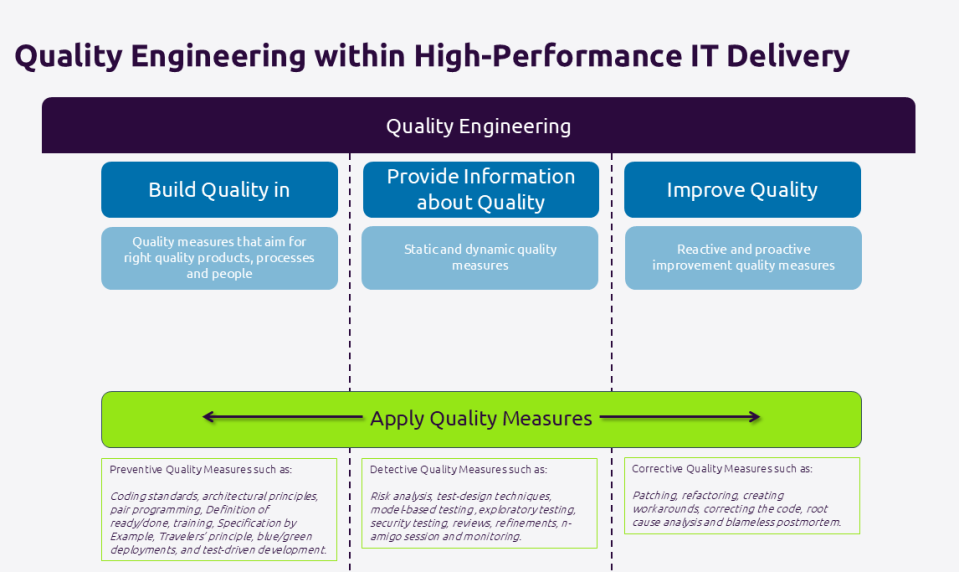Welcome to the first part of our Quality Engineering series! In this blog, we’ll explore how Quality Engineering aligns with testing, using a model to visualize the interrelationships of various quality measures. In future posts, we’ll explore the core aspects of Quality Engineering, its benefits for teams, and the key skills needed to succeed.
Quality Engineering (QE) and testing are both critical to successful IT delivery. Within TMAP we emphasize the benefits of both, as they are complementary. Some people mistakenly think that Quality Engineering is the same as testing. For better understanding, we have created a visual representation of how testing activities relate to Quality Engineering activities. And also, how do both contribute to IT delivery.
The figure below illustrates the overarching concept of Quality Engineering, which comprises three core elements: Build Quality in, Provide Information about Quality, and Improve Quality. Primary testing activities fall within the “provide information about quality” element of Quality Engineering. While testing is not the sole activity that provides information about quality, other informative activities include audits, code reviews, and inspections. Moreover, testers often do more than just provide information. Other Quality Engineering activities where testers are involved are within Build Quality in and Improve Quality, with the majority falling under Build Quality in.

IT delivery teams should be structured around the principles of Quality Engineering. This mindset and approach ensure that teams have the expertise needed to deliver high-quality software on time. For testers, Quality Engineering presents an opportunity to enhance their skills by focusing on various other quality measures. Most testers naturally adhere to a quality-focused philosophy, and we anticipate that the principles of Quality Engineering will resonate with them.
Quality Engineering is relevant for everyone
IT delivery teams should be capable of implementing effective, context-dependent Quality Engineering. While testers can bring attention to this subject, it is not solely their responsibility. Therefore, teams and their stakeholders should not overlook Quality Engineering. This is supported by the latest findings of the World Quality Report 2024-2025[1], which identifies ‘Quality Engineering skills’ as the most critical skill for IT delivery team members.
Quality Engineering requires everyone’s involvement in selecting and implementing quality measures. As a shared responsibility, everyone contributes to the success of Quality Engineering. Let’s look at why Quality Engineering is important for various roles:
Developers primarily focus on building the product right by applying quality measures such as coding standards, architectural principles, pair programming, and test-driven development.
Testers provide information about quality and risks so stakeholders can determine if the right product has been built, and the pursued business value will be delivered. Naturally critical and analytical, testers use various risk and value-based activities to evaluate a product, including risk analysis, test-design techniques, model-based testing and exploratory testing.
Operations cares about products that are easy to maintain, stable and reliable. Relevant quality measures are pipelines, monitoring, alerting, policies and patches.
Product owners make decisions about the product and play a vital role in Quality Engineering. Together with the team they decide which measures have priority.
Scrum masters and agile/quality coaches help the team build quality in and improve.
Users experience quality firsthand. They provide feedback and answer questions like, “Does this product satisfy my needs?”, “Is it fit for purpose?” and “Can I do my job with this?”.
Tailor made Quality Engineering
Regardless of their primary role, everyone involved should contribute to delivering a value and risk-based QE implementation. Ultimately, the goal is to establish the required level of confidence that the desired business value can be achieved, as suggested by the VOICE model.
Applying Quality Engineering to your IT delivery teams involves building quality in, providing information about quality, and improving quality where needed. Focus on risk, value, bottlenecks, and learn from mistakes made. This will lead to continuous improvement and a tailor-made implementation of Quality Engineering for your unique situation.
Opportunities for testers with Quality Engineering
For testers, Quality Engineering offers the opportunity to support broader quality measures beyond their traditional focus. This helps solve testability issues which makes testing faster, easier and less frustrating. It encompasses all aspects of the software development lifecycle. So, assess your team’s or product’s quality needs and step out of your comfort zone to explore the world of Quality Engineering.
This blog has been authored by Boyd Kronenberg
[1] https://www.capgemini.com/insights/research-library/world-quality-report-2024-25/

 English | EN
English | EN 